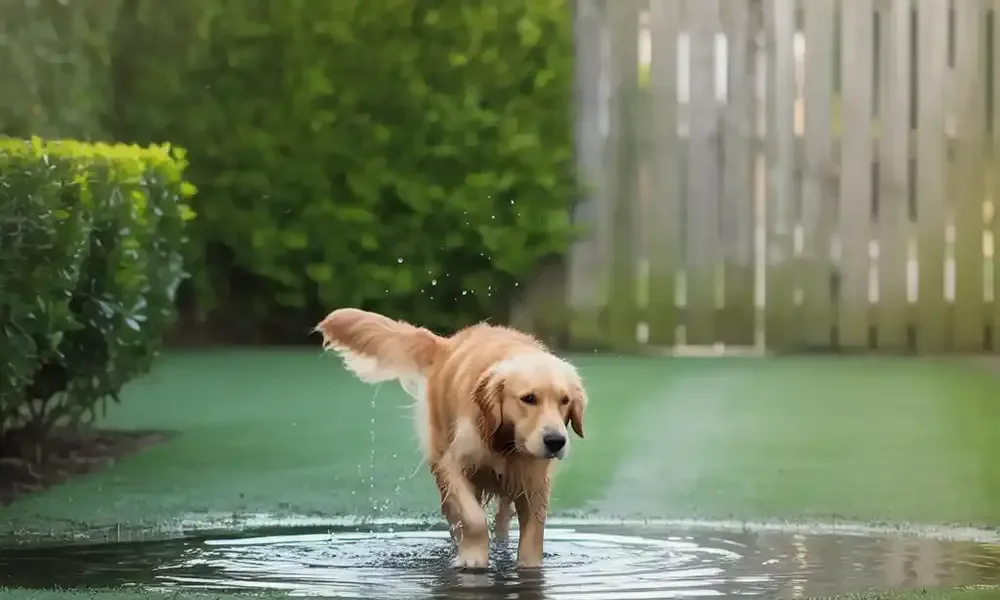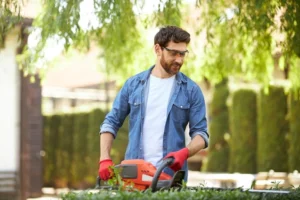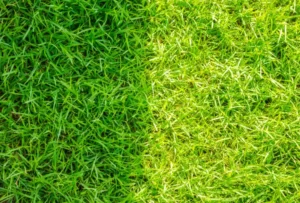How to clean turf from dog pee is a common concern among pet owners who have installed artificial grass in their yards. Artificial turf has become a popular alternative to natural grass due to its durability, low maintenance, and year-round greenery. For pet owners, it’s especially appealing since it can withstand the wear and tear caused by active dogs. However, one issue that often arises is that the turf smells like dog pee over time.
When dog pee on artificial grass isn’t cleaned properly, it can lead to unpleasant odors and hygiene concerns. Fortunately, there are simple solutions and effective cleaning methods to eliminate the smell and keep your turf fresh. In this guide, we’ll cover why artificial grass may retain odors, how to treat and prevent them, and the best practices for maintaining a clean, odor-free lawn that’s safe and enjoyable for both you and your pets.
What Happens to Artificial Turf When Dogs Pee?

Artificial grass is a popular low-maintenance alternative to natural lawns, especially for pet owners. But one common issue many people encounter is that turf smells like dog pee over time. Here’s why that happens and what to expect when there’s frequent dog pee on artificial grass.
How Artificial Turf Reacts to Dog Urine
Unlike natural grass, artificial turf doesn’t absorb liquids the same way. When a dog pees on artificial grass, the urine passes through the synthetic fibers and into the base layer beneath. While turf is designed to drain well, it doesn’t neutralize odors or break down waste like real soil and grass do. That means the urine can linger and lead to persistent smells unless it’s cleaned properly.
Why Turf Retains Smell More Than Natural Grass
Natural grass and soil contain microbes that help break down and neutralize urine. Artificial turf lacks this natural biological system. As a result, when there’s dog pee on artificial grass, the urine can build up in the infill layer (often made of sand or rubber pellets), causing the turf to smell like dog pee — especially in warm weather or if not rinsed regularly.
Impact of Repeated Urination in the Same Spots
Dogs often mark the same areas repeatedly, which can concentrate the urine in certain spots. Over time, this creates a buildup of ammonia and bacteria that intensifies the odor. The more frequently your dog urinates in the same location on artificial grass, the worse the smell can become, and it may even lead to turf discoloration or degradation of the backing material if not maintained.
For Turf Installation In The Bay Area you can contact Lakota Design Group.
What’s Causing My Artificial Turf to Smell Like Dog Urine?
If your artificial turf smells like dog urine, you’re not alone — this is a common issue among pet owners. The odor isn’t just unpleasant; it can become persistent if not properly managed. Understanding the root causes is key to effective odor control and cleaning artificial grass for dogs.
1. Bacteria and Ammonia Buildup
When dogs pee on artificial grass, the urine seeps through the turf and collects in the infill or base layer underneath. Over time, this leads to a buildup of bacteria and ammonia — the primary sources of that strong, lingering dog pee smell. Since synthetic turf doesn’t have the natural microbial activity of real soil, the urine isn’t broken down efficiently. Without regular cleaning of artificial grass for dogs, these odors will worsen.
2. Poor Drainage or Incorrect Installation
Artificial turf is designed to allow urine to drain through, but if it’s not installed properly — such as on a flat surface or without adequate sub-base material — urine can pool underneath. Trapped moisture combined with pet waste creates the perfect environment for bacteria to thrive, increasing the likelihood that your turf smells like dog pee. Proper drainage and a good base are essential to minimizing this issue.
3. Weather Factors Exacerbating the Odor
Hot and humid weather can intensify the smell of dog urine on artificial grass. Heat accelerates the release of ammonia vapors, making the odor much more noticeable in warmer months. If you’re not cleaning artificial grass for dogs consistently during these times, the smell can become overwhelming.
How to Clean Turf from Dog Pee in Easy Steps

Keeping your artificial lawn clean and odor-free doesn’t have to be a chore. If you’re dealing with dog pee on artificial grass, following a consistent cleaning routine can make all the difference. Here’s a simple step-by-step process for cleaning artificial grass for dogs and eliminating those unpleasant smells.
Step 1: Rinse Thoroughly
Rinse the area with a garden hose as soon as your dog has urinated. This dilutes the urine and helps flush it through the turf into the drainage system. Regular rinsing—especially in your dog’s favorite spots—prevents urine from soaking into the infill where it can cause persistent odor. Rinsing once or twice a week can greatly lessen accumulation..
Step 2: Apply a Pet-Friendly Enzyme Cleaner
Spray the area with a high-quality enzymatic cleaner — ideally the best turf cleaner for dog urine. These cleaners contain enzymes that break down the proteins and ammonia compounds in urine, eliminating the smell at its source instead of simply covering it up. Look for products that are non-toxic and safe for pets and children.
Step 3: Scrub with a Brush (If Needed)
Use a stiff-bristled brush to scrape the cleaner into the turf fibers and infill in areas that are significantly filthy or frequently visited. This lifts trapped residue and allows the enzymatic solution to penetrate deeper. Scrubbing is especially helpful if your turf hasn’t been cleaned in a while or if dog pee on artificial grass has created stubborn odor patches.
Step 4: Let It Dry Completely
Allow the area to dry completely before letting pets or people back on it. Proper drying helps prevent mold, bacteria growth, or the return of unpleasant smells. On sunny days, drying is faster, but good airflow is just as important. Avoid covering or walking on the turf until it’s fully dry.
You can also read about How Much Does Artificial Turf Cost?
How Do I Stop My Artificial Grass from Smelling? 4 Steps to Take
If your yard turf smells like dog pee, you’re not alone. Artificial grass can trap odors more than natural lawns, especially if it’s exposed to frequent pet use. Fortunately, with a few proactive measures, you can eliminate the smell and keep your turf fresh. Here are four effective steps to take for cleaning artificial grass for dogs and preventing lingering odors.
Step 1: Establish a Regular Cleaning Schedule
Consistent maintenance is key. Rinse down high-traffic pet areas with water at least 2–3 times a week, and use a pet-safe enzymatic cleaner weekly. The best turf cleaner for dog urine will break down organic waste and neutralize odors rather than just masking them. This is especially important if you notice frequent dog pee on artificial grass in the same areas.
Step 2: Train Dogs to Use a Specific Potty Area
Designate a small section of your yard for potty breaks. This makes cleanup easier and prevents widespread odor buildup. Place some of your dog’s waste in the designated area initially to encourage the habit. By concentrating dog pee on artificial grass in one spot, you can focus your cleaning efforts more effectively and prevent your entire lawn from smelling.
Step 3: Use Turf Deodorizers or Baking Soda Solutions
In between deep cleanings, turf deodorizers and natural remedies like baking soda can help absorb and neutralize mild smells. Sprinkle baking soda on dry turf, let it sit for 30–60 minutes, then rinse it off. Commercial turf deodorizers, especially those designed for pet use, are an excellent addition to your routine and work well when cleaning artificial grass for dogs.
Step 4: Ensure Proper Drainage During Installation
If your turf wasn’t installed with good drainage, odors are more likely to build up. Make sure your artificial grass has a proper sub-base (like crushed granite) and slopes slightly to encourage water flow. Poor drainage allows urine to pool and soak into the base layer, leading to that persistent turf smells like dog pee problem over time.
Conclusion
To keep your artificial grass fresh and odor-free, remember to rinse regularly, use the best turf cleaner for dog urine, train pets to use a designated area, and ensure proper drainage. Staying consistent with cleaning artificial grass for dogs helps prevent buildup and keeps your lawn looking and smelling great. Acting early is the key to avoiding long-term odor issues caused by dog pee on artificial grass.
Need expert help or product recommendations? Contact us today for personalized guidance and professional turf care solutions. Take action now and protect your turf investment!
FAQs
Q1: Why Does My Artificial Turf Smell Like Dog Pee?
Over time, dog pee on artificial grass can lead to ammonia buildup and bacterial growth, especially if not cleaned regularly. Artificial turf doesn’t absorb and break down waste like natural grass, which causes the smell to linger.
Q2: What Is The Best Turf Cleaner For Dog Urine?
The best turf cleaner for dog urine is an enzymatic cleaner designed for pet waste. These break down the urine at a molecular level, eliminating odors rather than just masking them. Look for products labeled pet-safe and non-toxic.
Q3: How Often Should I Be Cleaning Artificial Grass For Dogs?
For best results, rinse the turf a few times a week and use an enzymatic cleaner at least once a week. High-use areas or warmer climates may require more frequent cleanings to control odor.
Q4: Can I Use Vinegar Or Baking Soda To Clean Dog Pee From Turf?
Yes, a mix of vinegar and water or sprinkling baking soda can help with mild odors. However, for strong or persistent smells, enzymatic cleaners are more effective when cleaning artificial grass for dogs.
Q5: What If My Dog Keeps Peeing In The Same Spot?
Dogs tend to mark the same spots, which can lead to concentrated odor zones. Try retraining your dog to use a designated potty area and clean that spot more frequently with the best turf cleaner for dog urine.





